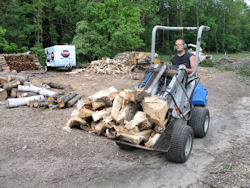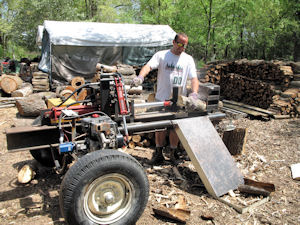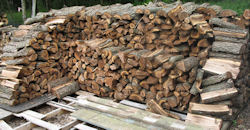| Our woodlot is located in SW Rochester and is
limited in size. Shawn Landon is responsible to keep
the wood lot clear of wood and brush so we can keep dumping wood as
we take down trees. This is not Shawn's main job, only a "hobby" job.
He chips the brush and cuts, splits and sells fire wood.
This image of the woodlot
contains hotspots that you can click on to enlarge different
areas to view details
In 2008 our company took a different direction in strategy.
We no longer bring all our brush to the woodlot. Instead we have
an arrangement with the local brush dump that makes it cheaper
to haul brush to the dump rather than chip it ourselves. It only makes good
business sense to contract out brush chipping if it is less
expensive to do so. The arrangement is a win win as it costs us
less to chip brush, the brush dump gets a little money for every
tree we take down and more product for mulch, as a bonus
we are not giving away chips to the landscapers anymore so they
purchase more mulch from the brush dump.
Shawn now is able to concentrate more of his efforts on the
firewood side keeping the woodlot clear for us to dump wood. Now we
bring mostly the big wood from jobs into the woodlot which can
be turned into
product we make money from. This means our firewood can be any
species from pine, cedar, cottonwood, hickory, ash, maple,
coffee bean, honey suckle and even buckthorn. However, due to Dutch elm disease,
we no longer bring elm into the lot, instead we take that to the
brush dump as well. I am sure that Ash may soon be on that list as well
(see ash borer or
blog article ).
 Our
MultiTrac plays a big role in the woodlot as well. On days we
are not using it to take trees done or other work, it is being
used in the woodlot to move brush and wood. We also bring all
our potential "money" logs to the woodlot and the MultiTrac is
used to sort and stack these logs until they are bought band
picked up by the log truck. We also have the "home made" log
splitter that attaches to the MultiTrac that can be used to
split firewood, we have not use that for a couple of years. We
also have another hydraulic splitter that we have been using
exclusively lately. We plan to build a motor to replace the use
of the MultiTrac for the other splitter as it is hard to break
the MultiTrac free from tree work to use at the wood lot. When
it is at the wood lot there is plenty of work to do besides
split wood. Our
MultiTrac plays a big role in the woodlot as well. On days we
are not using it to take trees done or other work, it is being
used in the woodlot to move brush and wood. We also bring all
our potential "money" logs to the woodlot and the MultiTrac is
used to sort and stack these logs until they are bought band
picked up by the log truck. We also have the "home made" log
splitter that attaches to the MultiTrac that can be used to
split firewood, we have not use that for a couple of years. We
also have another hydraulic splitter that we have been using
exclusively lately. We plan to build a motor to replace the use
of the MultiTrac for the other splitter as it is hard to break
the MultiTrac free from tree work to use at the wood lot. When
it is at the wood lot there is plenty of work to do besides
split wood.
Our firewood sales is year round and basically word of mouth.
We have no trouble selling out each winter. Since we are selling
what is brought into the woodlot, many species are not
what you call desirable species for firewood. Willow,
cottonwood, buckthorn, etc. are not high on anyone's list of
firewood. We have developed a unique category, by chance, call
camping firewood. This category has been a goldmine for our
firewood business. It all started one day when a customer stop
at our old lot and asked if they could pick up the junk
scattered around on the ground (that we were tripping over). He
came back several times and I found out he was going to the
river with his boat camping. The yard started looking good, and
one Sunday I cleaned it up and put all the junk in a trailer by
the road with a FREE sign on it. It was empty by day end. This
went on for several months. Soon, people were stopping on the way back
from the river to load up on wood knowing it would not be there
on Monday. Finally someone offered to buy the whole trailer each
week. We were putting junk, rotten wood, twigs, dirty wood,
broken, twisted, crotches, ... stuff we would normally chip or
burn in it and it was gone. Now people were buying it! This
became what we called "chumming" people came in to get the
CHEAP camping firewood and see all the "good stuff" and come
back in the fall to buy the expensive stuff. Our prices are as good or
lower than others, but our customers have developed a loyalty
for the cheap prices on the camping fire wood. Our woodlot is
immaculate! Marketing...you have to love it, our customers keep
my lot clean, we get rid of the junk, make money from waste and
develop clientele, they get a good deal on camping firewood.
With the economy slipping, firewood has been an even bigger
business. Customers have been buying wood that has been fresh
split anticipating the cost will go up in the fall. For the
first time we have brought wood into the lot that has not been
from a tree removal job just to use for firewood. Some wood has been from a
logging operation where the tops are not being utilized, others
are from give-a-ways in the paper. But each of these costs money
to transport equipment, load wood and haul.
Each winter we can provide about 10 cord of good oak wood and
at least 10-20 cord of mixed hard woods. Soft woods will be
about 20 cord as well depending how much of it gets put into
camping firewood. Camping firewood is about 50+ cord a year. We
chip or burn very little wood that is bigger that 1.5 inches
across no matter what the species.
Any wood will burn and when you are camping you are looking
for fire more than you are looking for heat. So the quality of
the wood does not matter as much.
|
|
| WALNUT FIREWOOD
 Many people think that the
only type of firewood worth buying is Oak. So firewood providers
have increased the prices on Oak fire wood since it is in such
high demand. Fact is that there are other alternative woods that
are as good or better than Oak. My belief, and I stress it is my
belief, is that the myth that Oak is the only firewood to buy
was formed by those who used to produce it. They did not really
produce the myth but they formulated it buy their method. They
were hand splitting firewood at that time and Oak fire wood was
by far the easiest to split and provided the best heat value and
was plentiful. There are other woods that have a better rating
on the "firewood scale" and other woods with a lower but
acceptable rating on this scale. But try to sell these woods to
most people and right away they think you are trying to "rip
them off" from buying their prized oak firewood. To be precise
there are actually two types of Oaks and one is not rated as
high as the other. Red Oak throws more sparks, is hard to burn
and has less heat than White Oak. On the other hand White Oak is
heaver. All of which really does not make a lot of difference,
which is my point. There are a lot of other woods that compare
similarly and without this rating chart you would not know the
difference. Ash is a good example while Blue Beech and Hickory
actually have a higher heat value than Oak but a harder
splitting rate (going back to my argument about hand splitting
and availability). Many people think that the
only type of firewood worth buying is Oak. So firewood providers
have increased the prices on Oak fire wood since it is in such
high demand. Fact is that there are other alternative woods that
are as good or better than Oak. My belief, and I stress it is my
belief, is that the myth that Oak is the only firewood to buy
was formed by those who used to produce it. They did not really
produce the myth but they formulated it buy their method. They
were hand splitting firewood at that time and Oak fire wood was
by far the easiest to split and provided the best heat value and
was plentiful. There are other woods that have a better rating
on the "firewood scale" and other woods with a lower but
acceptable rating on this scale. But try to sell these woods to
most people and right away they think you are trying to "rip
them off" from buying their prized oak firewood. To be precise
there are actually two types of Oaks and one is not rated as
high as the other. Red Oak throws more sparks, is hard to burn
and has less heat than White Oak. On the other hand White Oak is
heaver. All of which really does not make a lot of difference,
which is my point. There are a lot of other woods that compare
similarly and without this rating chart you would not know the
difference. Ash is a good example while Blue Beech and Hickory
actually have a higher heat value than Oak but a harder
splitting rate (going back to my argument about hand splitting
and availability).
Walnut firewood is a trend we have seen at our
woodlot. Some customers who own
outdoor wood burning furnaces ask for Walnut firewood. Since these customers have been
burning wood longer than most of the experts who write the
articles, I think I will trust the users. Regardless of what the
ratings say there is at least on column of statistics that is
always left off, the column called "practicality". In the case of Walnut fire wood
in outdoor furnaces, that column is "length of burn" and
"embers". Walnut has a unique tendency to flame while it burns
the bark and the light colored ring wood, but dies down as it
burns the thick heart wood. For this reason most people do not
like it as a fireplace wood as it does not provide a lot of
"atmosphere". You need a softwood to keep some flames burning.
But in the outdoor wood burning furnace these walnut logs will
burn all night long and keep your house toasty warm. |
|